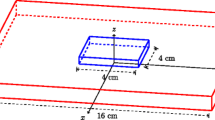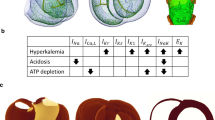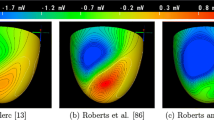Abstract
We quantify and provide biophysical explanations for some aspects of the relationship between the bidomain conductivities and ST-segment epicardial potentials that result from subendocardial ischemia. We performed computer simulations of ischemia with a realistic whole heart model. The model included a patch of subendocardial ischemic tissue of variable transmural thickness with reduced action potential amplitude. We also varied both intracellular and extracellular conductivities of the heart and the conductivity of ventricular blood in the simulations. At medium or high thicknesses of transmural ischemia (i.e., at least 40% thickness through the heart wall), a consistent pattern of two minima of the epicardial potential over opposite sides of the boundary between healthy and ischemic tissue appeared on the epicardium over a wide range of conductivity values. The magnitude of the net epicardial potential difference, the epicardial maximum minus the epicardial minimum, was strongly correlated to the intracellular to extracellular conductivity ratios both along and across fibers. Anisotropy of the ischemic source region was critical in predicting epicardial potentials, whereas anisotropy of the heart away from the ischemic region had a less significant impact on epicardial potentials. Subendocardial ischemia that extends through at least 40% of the heart wall is manifest on the epicardium by at least one area of ST-segment depression located over a boundary between ischemic and healthy tissue. The magnitude of the depression is a function of the bidomain conductivity values.
Similar content being viewed by others
References
Franzone, P., L. Colli, Guerri, M. Pennacchio, and B. Taccardi. Spread of excitation in 3-d models of the anisotropic cardiac tissue, iii. effects of ventricular geometry and fiber structure on the potential distribution. Math. Biosci. 151:51–98, 1998.
Hopenfeld, B., J. G. Stinstra, and R. S. MacLeod. Mechanism for ST depression associated with contiguous subendocardial ischemia. J Cardiovasc. Electrophysiol. 15:1200–1206, 2004.
Johnston, P. R., and D. Kilpatrick. The effect of conductivity values on st segment shift in subendocardial ischaemia. IEEE Trans. Biomed. Eng. 50:150–158, 2003.
Li, D., C. Y. Li, A. C. Yong, and D. Kilpatrick. Source of electrocardiograhpic ST changes in subendocardial ischemia. Circ. Res. 82:957–970, 1998.
MacLeod, R. S., and D. H. Brooks. Recent progress in inverse problems in electrocardiology. IEEE Eng. Med. Biol. Mag. 17:73–83, 1998.
Menown, I. B., R. S. Patterson, G. MacKenzie, and A. A. Adgey. Body-surface map models for early diagnosis of acute myocardial infarction. J. Electrocardiol 31(Suppl.):180–188, 1998.
Nielsen, P. M., I. J. LeGrice, B. H. Smaill, and P. J. Hunter. Mathematical model of geometry and fibrous structure of the heart. Am. J. Physiol. 260(4 Pt2):H1365–H1378, 1991.
Roberts, D. E., L. T. Hersch, and A. M. Scher. Influence of cardiac fiber orientation on wavefront voltage, conduction velocity and tissue resistivity. Circ. Res. 44:701–712, 1979.
Stinstra, J. G., B. Hopenfeld, and R. S. MacLeod. A model for the passive cardiac conductivity. Int. J. Bioelectromagn. 5(1):185–186, 2003.
van Oosterom, A., and R. Plonsey. The brody effect revisited. J. Electrocardiol. 24:339–48, 1991.
Author information
Authors and Affiliations
Corresponding author
Rights and permissions
About this article
Cite this article
Hopenfeld, B., Stinstra, J.G. & MacLeod, R.S. The Effect of Conductivity on ST-Segment Epicardial Potentials Arising from Subendocardial Ischemia. Ann Biomed Eng 33, 751–763 (2005). https://doi.org/10.1007/s10439-005-3236-2
Received:
Accepted:
Issue Date:
DOI: https://doi.org/10.1007/s10439-005-3236-2




